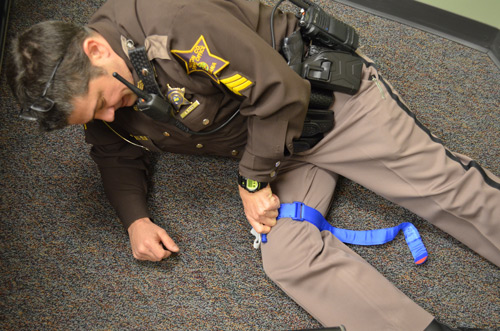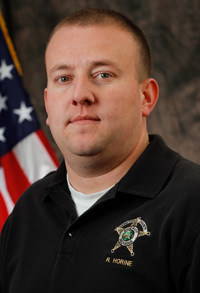This week approximately 140 Hamilton County Sheriff’s Department employees learned advanced emergency wound treatment techniques to help keep themselves and citizens safe in a changing world.

Hamilton County Sheriff’s Department Sgt. Scott Pass learns tourniquet self-application. (Photo provided)
Sgt. Mark Barker along with the department’s purchasing agent, Sgt. Ryan Horine, arranged for training classes and for new equipment for deputies and employees in all sheriff-controlled facilities in Hamilton County.
There were two sessions available each day throughout the week, allowing for smaller class sizes.
“It is a four-hour class,” Barker told The Reporter. “We have gone through a company called Workhorse. They are a training company composed of IMPD (Indianapolis Metropolitan Police Department) officers and IFD (Indianapolis Fire Department) officers.”
This training is not something new for the Sheriff’s Department, but rather knowledge that needed to be updated and expanded upon.

Barker
“Due to everything that’s going on in the world we wanted to get training for those who hadn’t had the training and update those who have had the training in the past,” Barker said. “Then we wanted to add more people from the corrections side as well because the training can work with gunshots and edged weapons wounds.”
Horine told The Reporter that front office and administrative staff are going through the same training.
“If something were to happen in one of our buildings, they would be able to treat themselves or one of their co-workers until another first-responder arrives on the scene,” Horine said. “It benefits ourselves, but it also benefits citizens. In that time when it’s somebody’s worst moment or when one of our guys is hurt, we are giving them the tools to self-treat, to be able to treat another officer or to treat a citizen. The value there is not only for us but also for the citizens.”

Horine
Horine further explained that this training is not just about gun violence. These skills can help with lacerations, chest wounds, crushing injuries from automobile accidents and other situations.
“These techniques can be used in a wide array of situations,” Horine said.
In addition to the class, employees and facilities are getting new equipment.
“We are outfitting all of our officers with new tourniquets, some new blood control items to include gauze, packing material and a variety of EMS supplies,” Horine told The Reporter. “Our officers have had form of this equipment before, but we are changing philosophies a little bit and equipping them with things they are more likely to see.”
Horine explained that a standard first-aid kit, such as those available at department stores, contains basic equipment needed in many home situations, but Sheriff’s Department officers and employees can face situations that require a great deal more.
“When we get called it is typically in people’s worst times,” Horine explained. “They call police, fire and EMS at the worst possible time in their lives on most occasions. When we get there, we need more than bee-sting cream and first-aid ointment. We need packing material, we need trauma pads, we need defibrillators, advanced tools that enable our guys to comfort or stop the potential loss of life at a moment’s notice.”
The updated kits are not just in patrol cars, but are also available all the sheriff controlled buildings.
Barker summed up the value of this training by saying, “I have more skills than I had before to help anybody who has an injury.”

